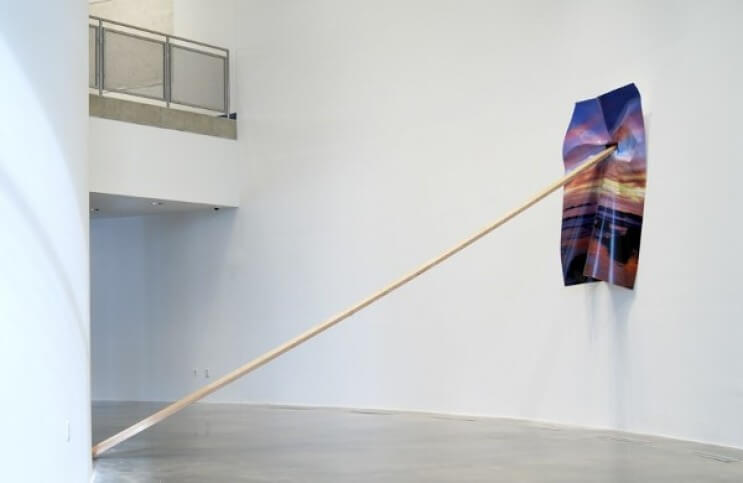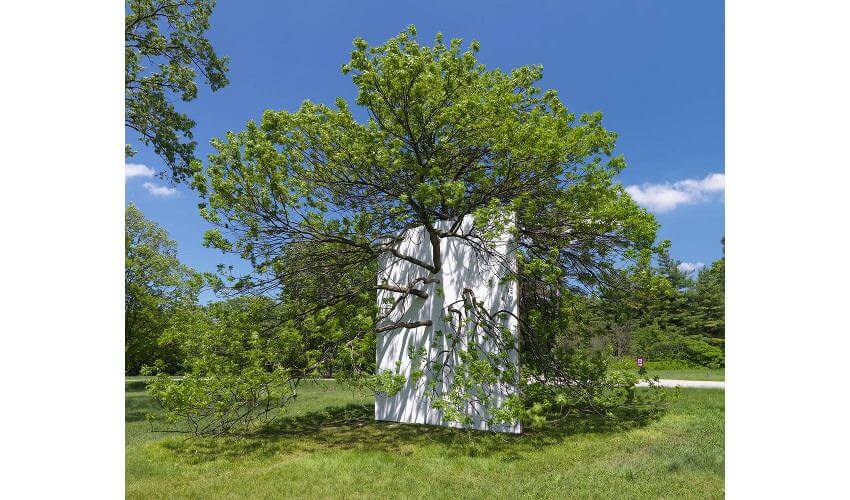
Forms of American Landscapes - The Art of Letha Wilson
The relationship between humanity and nature is complicated. Like everything we love, we strive to understand nature, imitate it, and exalt it; but then inevitably we also try to possess it, capture it, control it and exploit it, causing us sometimes to destroy it. Letha Wilson is perfectly suited to explore this odd relationship. She was born in Hawaii, one of the most idyllic natural settings in the world, and also one of the most tenuously developed. While she was still young her family moved to Colorado, an equally beautiful natural setting, and one equally imperiled by human encroachment. As a child she would go on extended hikes from the city into the wilderness, treading paths usually limited to wild creatures. Into the woods she brought her civilized mind: its structures, habits, methods and means. She returned with hints of alternative structures, natural methods, ancient habits, and primitive means. Like any modern person she took photographs of the landscapes she visited. But as an artist Wilson questioned what value such manufactured images have. Now living and working in Brooklyn, she is engaged in an increasingly succinct investigation of the ways human culture collaborates and competes with the natural world. Through a mix of photography, sculpture and installation, Wilson examines the relationships between false images and physical realities; the dependence between production, consumption and waste; the interplay between manufactured and natural forms; and the evolution of the ways human architecture blends with the outside world.
Extruded From Paradise
One of the earliest manifestations Letha Wilson arrived at to express her desire to meld photography and sculpture was a series of works she made in the early 2000s called Extrusions. Anyone who has ever played with a Play-Doh Fun Factory or made pasta with an extruder knows the thrill of forcing some soft substance through a form to create an elongated, specialty-shaped, three-dimensional tube. With her Extrusions, Wilson mimicked this effect by isolating particular objects in her landscape photographs and extruding their forms outward from the photograph onto the floor.
With her Extrusions, Wilson solved the problem of the two-dimensionality of photography. That is to say, photography supposedly captures the physical world, but it inevitably fails because it is flat. Extrusions bring photographs into physical space, making their imagery part of three-dimensionality reality once again. As objects, Extrusions are compelling on multiple other levels as well. In a visceral sense, they are whimsical, witty and eye-catching. Abstractly, they offer a range of interpretive possibilities, especially when considering the relationship between the viewer and whatever has been expelled from the image and thrust into space. And in an academic sense, these works simultaneously elevate landscape photography by making it contemporary while also subjugating it as a raw material for larger aesthetic phenomena.
 Letha Wilson - Extrusion of Five Palm Trees Near Lake Mead, Nevada, 2004, Digital print, styrofoam, wood, plaster, Aqua Resin, paint. © Letha Wilson
Letha Wilson - Extrusion of Five Palm Trees Near Lake Mead, Nevada, 2004, Digital print, styrofoam, wood, plaster, Aqua Resin, paint. © Letha Wilson
Natural Constructs
After several years of working within the gallery world, Letha Wilson found herself increasingly aware of the amount of waste cast off by the art exhibition system. In an effort to address this, she embarked on multiple projects that confronted specifically the idea of temporary walls. In some of her projects she simply utilized the discarded scraps of wood and drywall that are routinely thrown in the trash after the dismantling of temporary studio or exhibition spaces. For example, for one such project Wilson reused the drywall from the studio of a friend, turning the scraps into a classical fountain. Water of course destroys drywall in time, but that is part of the work, as natural forces are allowed to gradually wear down the human-made materials.
In another project, Letha confronted this idea by intervening directly into the environment from which building materials originate. She built a temporary gallery wall in situ, nestled in the branches of a Blue Ash tree at the Morton Arboretum in Lisle, Illinois. One of several walls-in-trees Wilson created, this project made an astonishing visual impact as it began when there were no leaves on the tree and gradually transformed as nature took its course. Conceptually, Wall in Blue Ash Tree might be read as a comment on the futility of making art that can compete with nature, but it could also be seen as asserting the importance of human intervention in the aesthetic process.
 Letha Wilson - Wall in Blue Ash Tree, 2011, Drywall, joint compound, paint, wood studs. © Letha Wilson
Letha Wilson - Wall in Blue Ash Tree, 2011, Drywall, joint compound, paint, wood studs. © Letha Wilson
Stone Free
More recently, Letha Wilson has returned to the amalgam of photography and sculpture to explore her core ideas surrounding humanity, nature, materiality, and the relationship between manufactured and natural spaces. Her latest works involve combinations of cement, concrete, metal and wood with landscape photographs she shoots, develops and prints herself. The visual impact of these photo-sculptures is immediate. They address the relationship between humanity and nature, and make statements about its visual results. They bring the gallery into nature and nature into the gallery, combining them in ways that are both uncanny and sublime. They make sense, and feel inevitable.
Bit if there is a commentary being made by Wilson, it is subjective. Her works encourage contemplation but stop short of judgment. The process in which Wilson engages is intimately related to the traditions of craft. It exposes the waste of existing studio and exhibition models, but also exploits it. It questions the power of photography to communicate something real, but also proves that photography, rather than being an outdated or overused medium, can still play a vital role in translating essential aspects of the natural world. On one level her work exposes the strange and questionable ways humanity interacts with resources and alters the natural world. But on another level it elevates human materials and processes to something sublime.
 Letha Wilson - Badlands Joshua Tree Concrete Bend, 2015, C-prints, concrete, emulsion transfer, aluminum frame. © Letha Wilson
Letha Wilson - Badlands Joshua Tree Concrete Bend, 2015, C-prints, concrete, emulsion transfer, aluminum frame. © Letha Wilson
Featured image: Letha Wilson - California Sunset Lean, 2014, Digital print on vinyl, wood, drywall
All photos used for illustrative purposes only
By Phillip Barcio






